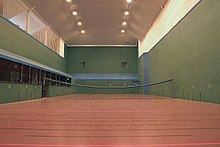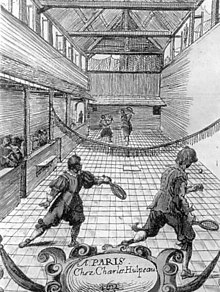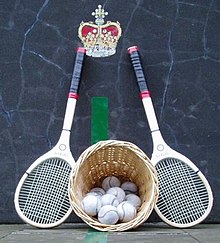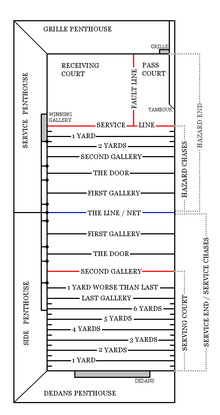Jeu de paume
![]()
This article is about the precursor of tennis. For the museum in Paris, see Galerie nationale du Jeu de Paume.
Jeu de Paume (French for "game with the palm of the hand") was a precursor of tennis, the game of which is documented as early as the Middle Ages in cloisters. It is played with walls, as in squash. For a detailed description of its origins, see History of Tennis. Jeu de paume was first mentioned in a document in 1250, when monks were forbidden to play against laymen. Due to the exact counting of points, without regard to rank or standing, it can be considered one of the first modern sports.
Jeu de Paume was an Olympic discipline in London in 1908 and a demonstration sport at the 1924 Games in Paris and the 1928 Games in Amsterdam. The only Olympic champion in the history of this sport is the American George Jay Gould II.
Today, this form of tennis is played by only about 10,000 athletes, about a third of whom are women. They are spread over just under 50 courts in Great Britain (Real Tennis), the United States (Court Tennis), Australia (Royal Tennis) and France (Jeu de Paume). Contrary to what the French name suggests, Jeu de Paume is usually played with a wooden racket, although its eponymous origins lie in bare-handed or gloved play.
The World Championships are played every two years. The top four players in the world rankings (with the exception of the reigning world champion) determine the challenger, who then competes against the defending champion in a match over seven winning sets within three days. Australian Robert Fahey has been the world champion in the sport since 1994. In 2016, he lost to Camden Riviere and took the title again in 2018. Fahey is the only player in the sport to be ranked as a professional.

The Bristol Bath Tennis Hall in England

Jeu de paume in the 17th century
Equipment
Rackets
The rackets usually consist of a wooden frame with an asymmetrical nylon-covered head of max. 241.3 mm (9.5″) length and 177.8 mm (7″) width. The overall length of the racket is max. 685.8 mm (27″).
Balls
The balls used shall be hand sewn felt balls with a cork core. The diameter must be between 61.9 mm (2 7/16″) and 65.1 mm (2 9/16″) and the weight between 70.9 g (2.5 OZ) and 78 g (2.75 OZ).

Jeu-de-Paume equipment
Field
The playing fields are not standardized but range in size from 33.53 × 11.89 m (110 × 39 ft) to 29.26 × 9.75 m (96 × 32 ft) and are doubly asymmetrical. Jeu de Paume (German "Ballhaus") is also the name of the hall in which this game was played.

Playing field diagram
Questions and Answers
Q: What is Jeu de paume?
A: Jeu de paume is a French game similar to lawn tennis, but played without racquets where the players hit the ball with their hands as in volleyball.
Q: What is the literal meaning of Jeu de paume?
A: Jeu de paume literally means game of palm (of the hand).
Q: When did gloves replace bare hands in Jeu de paume?
A: After some time gloves replaced bare hands in Jeu de paume.
Q: What happened when bats and finally racquets became standard equipment for Jeu de paume?
A: Even when bats, and finally racquets, became standard equipment for Jeu de paume, the name did not change.
Q: What did Jeu de paume become known as in English?
A: Jeu de paume became known as "tennis" in English.
Q: Why are several important buildings in France called Jeu de paume?
A: Several important buildings in France are known by the name Jeu de paume because they are near to tennis courts or to sites on which courts once stood.
Q: What is the famous serment du jeu de paume?
A: The famous serment du jeu de paume is a work of art depicting the formal announcement of the French revolution made in the Royal Tennis Court there on 20 June, 1789.
Search within the encyclopedia